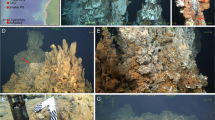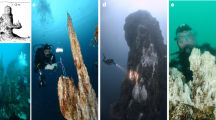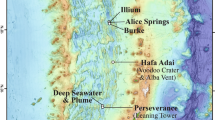Abstract
The physiology and biochemistry of many taxa inhabiting deep-sea hydrothermal vents have been elucidated1,2,3,4; however, the physicochemical factors controlling the distribution of these organisms at a given vent site remain an enigma after 20 years of research5,6,7,8,9,10,11. The chemical speciation of particular elements has been suggested as key to controlling biological community structure in these extreme aquatic environments7,11,12. Implementation of electrochemical technology13,14 has allowed us to make in situ measurements of chemical speciation at vents located at the East Pacific Rise (9° 50′ N) and on a scale relevant to the biology. Here we report that significant differences in oxygen, iron and sulphur speciation strongly correlate with the distribution of specific taxa in different microhabitats. In higher temperature (> 30 °C) microhabitats, the appreciable formation of soluble iron-sulphide molecular clusters markedly reduces the availability of free H2S/HS- to vent (micro)organisms, thus controlling the available habitat.
This is a preview of subscription content, access via your institution
Access options
Subscribe to this journal
Receive 51 print issues and online access
$199.00 per year
only $3.90 per issue
Buy this article
- Purchase on Springer Link
- Instant access to full article PDF
Prices may be subject to local taxes which are calculated during checkout



Similar content being viewed by others
References
Cavanaugh, C. et al. Prokaryotic cells in the hydrothermal vent tube worm Riftia pachyptila: Possible chemoautrophic symbionts. Science 213, 340–342 (1981).
Felbeck, H. Chemoautrophic potential of the hydrothrmal vent tube worm Riftia pachyptila Jones (Vestimentifera). Science 213, 336–338 (1981).
Childess, J. J. & Mickel, T. J. Oxygen and sulfide consumption rates of the clam Calyptogena pacifica. Mar. Biol. Lett. 3, 73 (1982).
Goffredi, S. K., Childress, J. J., Desauliniers, N. T. & Lallier, F. H. Sulfide acquisition by the vent worm Riftia pachyptila appears to be via uptake of HS-, rather than H2S. J. Exp. Biol. 200, 2609–2616 (1997).
Desbruyeres, D. et al. Biology and ecology of the ‘pompeii worm’ (Alvinella pompejana Desbruyeres and Laubier) a normal dweller of an extreme deep-sea environment: a synthesis of current knowledge and recent developments. Deep-Sea Res. II 45, 383–422 (1998).
Sarradin, P. M. et al. Chemical and thermal description of the environment of the genesis hydrothermal vent community (13° N, EPR). Cah. Biol. Mar. 39, 159–167 (1998).
Shank, T. M. et al. Temporal and spatial patterns of biological community development at nascent deep-sea hydrothermal vents (9o50′N, East Pacific Rise). Deep-Sea Res. II 45, 465–515 (1998).
Cary, S. C., Shank, T. & Stein, J. Worms bask in extreme temperatures. Nature 391, 545–546 (1998).
Chevaldonné, P., Desbruyères, D. & Childress, J. J. Some like it hot and some even hotter. Nature 359, 593–594 (1992).
Juniper, S. K. & Martineu, P. Alvenillids and sulfides at hydrothermal vents of the eastern Pacific: a review. Am. Zool. 35, 74–185 (1995).
Johnson, K. S., Beehler, C. L., Sakamoto-Arnold, C. M. & Childress, J. J. In situ measurements of chemical distributions in a deep-sea hydrothermal vent field. Science 231, 1139–1141 (1986).
Von Damm, K. L. in Seafloor Hydrothermal Systems (eds Humphris, S. E., Zierenberg, R. A., Mullineaux, L. S. & Thomson, R. E.) 222–247 (American Geophysical Union, Washington DC, 1995).
Brendel, P. J. & Luther, G. W. III Development of a gold amalgam voltammetric microelectrode for the determination of dissolved Fe, Mn, O2 and S(-II) in porewaters of marine and freshwater sediments. Environ. Sci. Technol. 29, 751–761 (1995).
Luther, G. W. III, Reimers, C. E., Nuzzio, D. B & Lovalvo, D. In situ deployment of voltammetric, potentiometric and amperometric microelectrodes from a ROV to determine O2, Mn, Fe, S(-2) and pH in porewaters. Environ. Sci. Technol. 33, 4352–4356 (1999).
Cline, J. E. Spectrophotometric determination of hydrogen sulfide in natural waters. Limnol. Oceanogr. 14, 454–458 (1969).
Rickard, D. T. & Luther, G. W. III Kinetics of pyrite formation by the H2S oxidation of iron(ii) monosulfide in aqueous solutions between 25 °C and 125 °C: the mechanism. Geochim. Cosmochim. Acta 61, 135–147 (1997).
Theberge, S. M. & Luther, G. W. III Determination of the electrochemical properties of a soluble aqueous FeS cluster present in sulfidic systems. Aq. Geochem. 3, 191–211 (1997).
Rozan, T. F., Theberge, S. M. & Luther, G. W. III Quantifying elemental sulfur (S0), bisulfide (HS-) and polysulfides (S2-x) using a voltammetric method. Anal. Chim. Acta 415, 175–184 (2000).
Cary, S. C., Cottrell, M. T., Stein, J. L., Camacho, F. & Desbruyères, D. Molecular identification and localization of filamentous symbiotic bacteria associated with the hydrothermal vent annelid Alvinella pompejana. Appl. Environ. Microbiol. 63, 1124–1130 (1997).
Di Meo, C. A., Wakefield, J. R. & Cary, S. C. A new device for sampling small volumes of water from marine micro-environments. Deep-Sea Res. I 46, 1279–1287 (1999).
Rickard, D. T. Kinetics of pyrite formation by the H2S oxidation of iron(ii) monosulfide in aqueous solutions between 25 °C and 125 °C: the rate equation. Geochim. Cosmochim. Acta 61, 115–134 (1997).
Millero, F. J., Plese, T. & Fernandez, M. The dissociation of hydrogen sulfide in seawater. Limnol. Oceanogr. 33, 269–274 (1988).
Luther, G. W. III, Ferdelman, T. G., Kostka, J. E., Tsamakis, E. J. & Church, T. M. Temporal and spatial variability of reduced sulfur species (FeS2, S2O2-3) and porewater parameters in salt marsh sediments. Biogeochemistry 14, 57–88 (1991).
Stookey, L. L. Ferrozine—a new spectrophotometric reagent for iron. Anal. Chem. 41, 779–782 (1970).
Acknowledgements
We thank A. L. Reysenbach, K. Longnecker, the DSV Alvin pilots (P. Hickey, S. Faluotico and B. Williams), and the crew and Captain of the R/V Atlantis for their help and encouragement. This work was funded by grants from the National Science Foundation and the National Aeronautics and Space Administration, and by the University of Delaware Sea Grant Program through the National Oceanic and Atmospheric Administration, and the Devonshire Foundation.
Author information
Authors and Affiliations
Corresponding author
Rights and permissions
About this article
Cite this article
Luther, G., Rozan, T., Taillefert, M. et al. Chemical speciation drives hydrothermal vent ecology. Nature 410, 813–816 (2001). https://doi.org/10.1038/35071069
Received:
Accepted:
Issue Date:
DOI: https://doi.org/10.1038/35071069
This article is cited by
-
Spontaneous assembly of redox-active iron-sulfur clusters at low concentrations of cysteine
Nature Communications (2021)
-
The microbiomes of deep-sea hydrothermal vents: distributed globally, shaped locally
Nature Reviews Microbiology (2019)
-
Characteristics and Evolution of sill-driven off-axis hydrothermalism in Guaymas Basin – the Ringvent site
Scientific Reports (2019)
-
Antagonistic evolution of an antibiotic and its molecular chaperone: how to maintain a vital ectosymbiosis in a highly fluctuating habitat
Scientific Reports (2017)
Comments
By submitting a comment you agree to abide by our Terms and Community Guidelines. If you find something abusive or that does not comply with our terms or guidelines please flag it as inappropriate.



